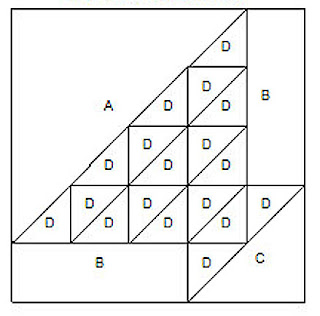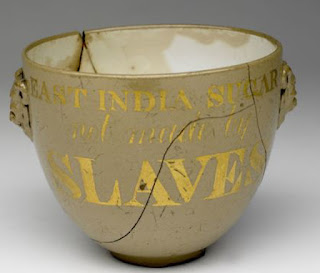Block 5 Union Basket
by Barbara Brackman
11" finished basket in a 15" finished block
My top is at the quilter's.
Lori Kukuk should be done soon.
From Carrie's diary, May 1, 1861.
" A lot of us girls went down to the train and took flowers to the soldiers as they were passing through and they cut buttons from their coats and gave to us as souvenirs.
Dozens of designs for patriotic envelopes were printed.
"We have flags on our paper and envelopes, and have all our stationery bordered with red, white and blue. We wear little flag pins for badges and tie our hair with red, white and blue ribbon and have pins and earrings made of the buttons the soldiers gave us.
"The Star Spangled Banner"
"We are going to sew for them in our society and get the garments all cut from the older ladies society. They work every day in one of the rooms of the court house and cut out garments and make them and scrape lint and roll up bandages. They say they will provide us with all the garments we will make. We are going to write notes and enclose them in the garments to cheer up the soldier boys. It does not seem now as though I could give up any one who belonged to me.
Abbie Clark Williams's
quilt.
Collection of the Ontario County Historical Society
"The girls in our society say that if any of the members do send a soldier to the war they shall have a flag bed quilt, made by the society, and have the girls' names on the stars."Canandaigua's Young Ladies' sewing society was good as their word. When Abbie Clark married Captain George Norton Williams after the war they presented her with a flag quilt. The stars are inked with the names of her friends including Carrie Richards.
Abbie Clark.
She looks just like the woman in the
Star Spangled Banner illustration.
She looks just like the woman in the
Star Spangled Banner illustration.
Abigail Stanley Clark Williams (1843-1902) was the youngest of four daughters of Myron Holley Clark and Zilpha Watkins Clark. Her father was Governor of New York from 1855 to 1857, a member of the Whig party and an advocate of temperance and antislavery.
Sisters Mary and Zilpha were also Carrie's friends.
The stitchers squeezed 36 stars into the blue field on Abbie's quilt, the number of stars on the flag from 1865 to 1867.
Becky Brown's Basket.
She added a few leaves.
Union Basket
See last Saturday's post for more information about the inspiration for this basket block.
Union Basket by Denniele Bohannon.
Her background is navy blue.
Denniele's embroidered her words.
This is the last of the words---
except for your signature and date of course.
This month's block celebrates the Union, capturing the spirit of Canandaigua in the first few months of the war. The inspiration is a basket block found in two antique quilts.
The block finishes to 15", but the pieced basket is
actually an 11" finished block, pieced into a larger square.
Cutting the Basket
B - Cut 2 rectangles 2-3/4 x 7-1/8".
C - Cut a square 5-1/4". Cut in half diagonally to make 2 triangles. You need 1 triangle.
D - Cut at least 9 squares 3". Cut each in half diagonally to make 2 triangles. You need 18 triangles of various shades.
E - For the handle cut a strip of bias 19" long x 1" and turn under to finish 1/2" wide. I used an old 45 record as a template for the curve.
The basket fits on point into a 15" finished block. For the edge triangles cut 2 squares 11-1/2". Cut each in half diagonally to make 2 triangles. You need 4 triangles.
Letters
The word UNION should print out 1-1/2" inches tall and 5-2/4" long.
Add seams for traditional applique.
To Print:
- Create a word file or a new empty JPG file.
- Click on the image above.
- Right click on it and save it to your file.
- Print that file. Check to be sure the word is 5-3/4" long.
Using the templates cut the letters UNION. (Add seams.) Glue or baste the edges under. Or embroider---or print, paint, etc.
Flag
Use a backwards flag from Block 2 (you made 4). Glue or baste the edges under.
For the flag pole cut a strip 1" x 2". Glue or baste the edges under.
Sewing
Applique the handle & letters first to triangle A.
Leave the top of the O letter unstitched so you can insert the flagpole later.
Piecing the basket
Applique the flag and flagpole over the basket handle. Close the top of the O as you add the flagpole.
A sewing society, detail of a drawing by Winslow Homer.
Harper's Weekly
From the Ontario Repository:
Canandaigua, April, 1861.
"The Ladies are all for the Union.
We observed a beautiful flag, with the Stars and Stripes floating from the Observatory of the Ontario Female Seminary. We learn that it was made by the young ladies themselves....
In spite of the latest Parisian fashions, the tri-colored tints that are borne on our national standard is preferred by the ladies in making up some of the essential articles of their wardrobes....A meeting of ladies was held at the town house....suitable material for a large number of bed ticks was distributed among those present to be immediately made up."
Becky's block Photoshopped without leaves.
Look at those letters!

































































